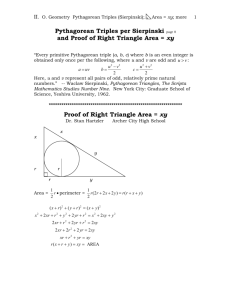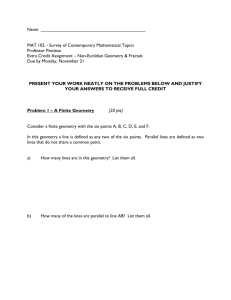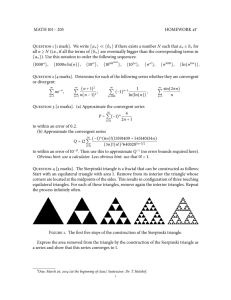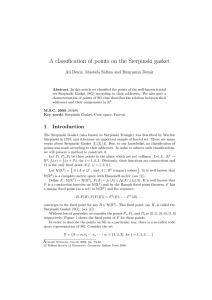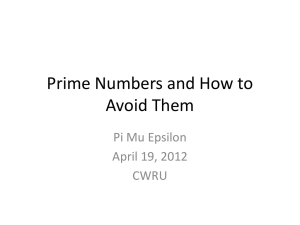A TOPOLOGY WITH ORDER, GRAPH AND AN ENUMERATION PROBLEM
advertisement
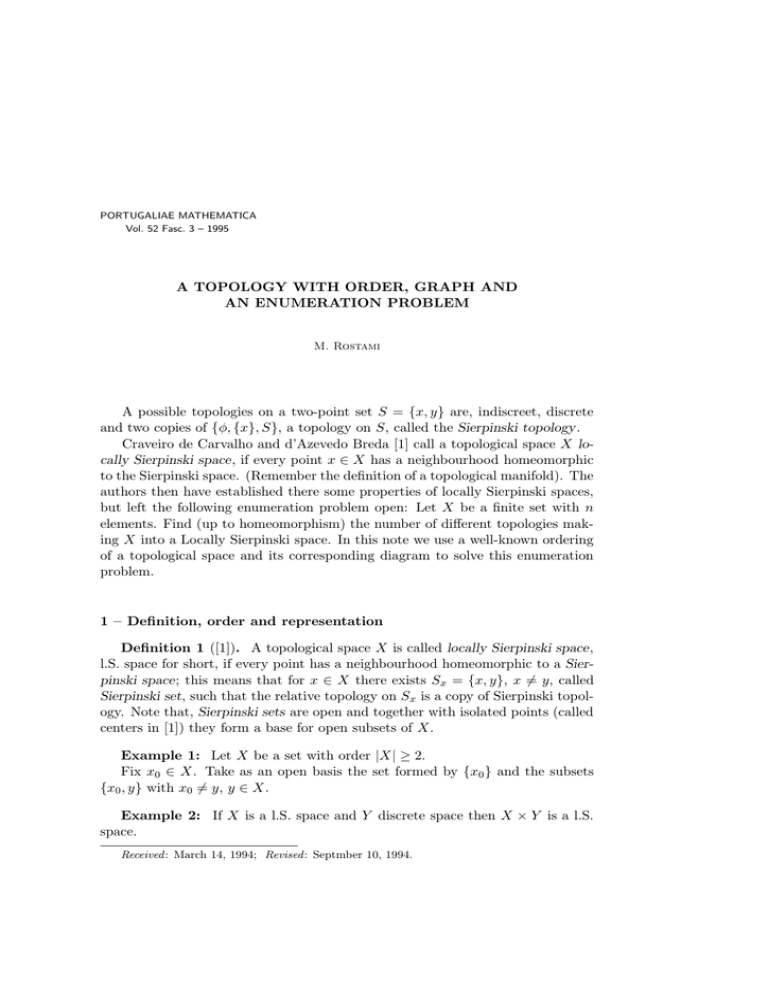
PORTUGALIAE MATHEMATICA
Vol. 52 Fasc. 3 – 1995
A TOPOLOGY WITH ORDER, GRAPH AND
AN ENUMERATION PROBLEM
M. Rostami
A possible topologies on a two-point set S = {x, y} are, indiscreet, discrete
and two copies of {φ, {x}, S}, a topology on S, called the Sierpinski topology.
Craveiro de Carvalho and d’Azevedo Breda [1] call a topological space X locally Sierpinski space, if every point x ∈ X has a neighbourhood homeomorphic
to the Sierpinski space. (Remember the definition of a topological manifold). The
authors then have established there some properties of locally Sierpinski spaces,
but left the following enumeration problem open: Let X be a finite set with n
elements. Find (up to homeomorphism) the number of different topologies making X into a Locally Sierpinski space. In this note we use a well-known ordering
of a topological space and its corresponding diagram to solve this enumeration
problem.
1 – Definition, order and representation
Definition 1 ([1]). A topological space X is called locally Sierpinski space,
l.S. space for short, if every point has a neighbourhood homeomorphic to a Sierpinski space; this means that for x ∈ X there exists Sx = {x, y}, x 6= y, called
Sierpinski set, such that the relative topology on Sx is a copy of Sierpinski topology. Note that, Sierpinski sets are open and together with isolated points (called
centers in [1]) they form a base for open subsets of X.
Example 1: Let X be a set with order |X| ≥ 2.
Fix x0 ∈ X. Take as an open basis the set formed by {x0 } and the subsets
{x0 , y} with x0 6= y, y ∈ X.
Example 2: If X is a l.S. space and Y discrete space then X × Y is a l.S.
space.
Received : March 14, 1994; Revised : Septmber 10, 1994.
338
M. ROSTAMI
A topological space X is Alexandroff space [3] iff, every point has a smallest
neighborhood or equivalently arbitrary intersection of open sets is open. It is
evident that, a l.S. space is T0 -Alexandroff space.
Let X be a l.S. space and {y} denote the closure of {y} in X.
The Alexandroff specialization order: x ≤ y if x ∈ {y}, x, y ∈ X, makes X a
partially ordered set (poset). For A ⊆ X, define ↓ A = {x : ∃ y ∈ A such that
x ≤ y}. Then ↓ A = A if A is closed therefore the topology of a l.S. space is
completely determined by its specialization order. Note that, specialization order
≤ on l.S. space X is partial order on X, precisely because X satisfies T0 -axiom.
Proposition 1. Let X be a l.S. space equipped with specialization order.
Then for x ∈ X, {x} is either open or closed. Furthermore with respect to this
order, isolated points are maximal and closed points are minimal.
Proof: If {x} is not open, then there exists y ∈ X such that Sx = {x, y} is
open. Now y ∈ Sx implies that x ∈ {y} so x ≤ y and there exists z 6= y such that
{x, z} is open. Hence if z ∈ {x} and z 6= y then z = x, this means that {x} = {x}
and also x is minimal. If x ≤ y, {y} intersects every open set containing x, so if
{x} is open then x = y and x is maximal.
We need the following Corollary later.
Corollary 1. If X is a finite l.S. space of size n, then the number of isolated
points can not exceed [ n2 ], the integral part of n2 .
Proof: Since every point is open or closed (maximal or minimal) but not
both, the proof is clear.
Posets traditionally represented in more economical way by an acyclic directed
graph, called Hasse diagram.
By Proposition 1, the Hasse diagram of a l.S. space as poset is bipartite upward directed graph, with maximal (top) elements as isolated points and minimal
elements as closed points.
Hence:
Each l.S. space with respect to its natural order determines a unique bipartite
graph, with directed edges representing Sierpinski sets and they intersect (if any)
only on centres (maximal points). Clearly two such spaces are homeomorphic
if, their corresponding graphs are isomorphic. The above discussion leads to the
following representation theorem.
Theorem 1. Let X be a l.S. space. Then X can be represented as an ordered
bipartite space, having as a diagram a certain transitive digraph with directed
A TOPOLOGY WITH ORDER, GRAPH AND AN ENUMERATION PROBLEM
339
edges representing Sierpinski sets. Conversely, any such bipartite order (poset)
determines a unique l.S. space.
Proof: Suppose X is a l.S. space. Then X = A ∪ B where A and B are
disjoint subsets of open (isolated) points and closed points of X respectively. Now
the order of specialization makes X an ordered bipartite space.
Since isolated points and Sierpinski sets are basic open sets in X, all upper
sets (i.e. sets U such that x ∈ U and x ≤ y implies y ∈ U ) are open in X.
Conversely, let (X, ≤) be a poset, X = A ∪ B, where A, B are disjoint subsets
of maximal and minimal elements of X respectively. Suppose for each b ∈ B
there exists a unique element a ∈ A such that b ≤ a. Topologise X by
n
o
n
o
B = {a} : a ∈ A ∪ (a, b) : a ∈ A, b ∈ B, b ≤ a ,
as a base for open sets. The ordered bipartite space X now is clearly a l.S. space
in which the order of specialization agrees with defining order on X.
The author is indebted to the referee for suggesting the above theorem.
Example 3: Let X = {a, b, c, d} with topologies
n
τ1 = φ, {a}, {a, b}, {a, c}, {a, d}, {a, b, c}, {a, b, d}, {a, c, d}, X
o
and
n
τ2 = φ, {a}, {b}, {a, b}, {a, c}, {b, d}, {a, b, c}, {a, b, d}, X
o
.
The bipartite graphs representing these topologies are G1 and G2 respectively.
See Fig. 1
Fig. 1
340
M. ROSTAMI
Example 4: The possible diagrams for a l.S. space X of order |X| = 7 are
as Fig. 2
Fig. 2
So we have only four topologies each one making X, |X| = 7 a locally Sierpinski space.
2 – Partitions of integers and counting topologies
A partition of a number n is a representation of n as the sum of any number
of integral parts.
The number of partitions of n is usually denoted by p(n). For example we
have
p(1) = 1 ,
p(4) = 3 = 2 + 1 = 1 + 1 + 1 ,
p(4) = 5 : 4 = 3 + 1 = 2 + 2 = 2 + 1 + 1 = 1 + 1 + 1 + 1 .
We also define p(0) = 1.
The ordinary generating functions provide a simple way for counting these
numbers. In case of finitely many p(0), p(1), ..., p(n), the generating function is
as follows
1
G(x) =
,
(1 − x) (1 − x2 ) · · · (1 − xn )
see [3].
Note that the coefficient of xj is the number of partitions of j into summands
that do not exceed n.
For example in
G(x) =
1
= 1 + x + 2x2 + 3x3 + 4x4 + 5x5 + 6x6 + ...
(1 − x) (1 − x2 ) (1 − x3 )
there are three ways to partition 3 and seven ways to partition the integer 6 with
no parts exceeding 3.
We need the following proposition in the sequel. For the proof, see [3].
A TOPOLOGY WITH ORDER, GRAPH AND AN ENUMERATION PROBLEM
341
Proposition 2. The ordinary generation function of the number of partitions
of positive integer n into exactly m parts is
G(x) =
xm
.
(1 − x) (1 − x2 ) · · · (1 − xm )
Let X be a finite set of size n ≥ 2. Determine the number of different topologies (up to homeomorphism) making X into a locally Sierpinski space.
Note that a typical representation of a l.S. space X, with |X| = n, as bipartite
graph might looks like (see Fig. 3).
where 1 ≤ m ≤
Fig. 3
h i
n
2
.
Now, our main conclusion in this section is as follows.
Given positive integers n and m, 1 ≤ m ≤ [ n2 ], the number of l.S. topological
structures on the set X with size |X| = n and the number of isolated points m,
is equal to the number of partitions of n into m parts. Therefore, if we denote by
pnm the number of such partitions, then the number of l.S. spaces on X is equal
to
· ¸
n
n−1
n−2
n−m
.
p1 + p2 + ... + pm
where 1 ≤ m ≤
2
For example if n = 7 (see Example 4) since pn−1
= 1 and generating functions
1
for n = 2 and n = 3 are
x2
= x2 + x3 + 2x4 + 3x5 + 3x6 + ...
(1 − x) (1 − x2 )
and
x3
= x3 + x4 + 2x5 + 3x6 + 7x7 + ...
(1 − x) (1 − x2 ) (1 − x3 )
respectively, we have
p61 + p52 + p43 = 1 + 2 + 1 = 4 ,
as we were expecting.
342
M. ROSTAMI
REFERENCES
[1] Craveiro de Carvalho, F.J. and d’Azevedo Breda, A.M. – Alguns passos
em volta de Espaço de Sierpinski, Boletim da Sociedade Portuguesa de Matemática,
28 (1994), 59–63.
[2] Gierz, G. et al – A Compendium of Continuous Lattices, Springer-Verlag, Berlin,
1980.
[3] Liu, C.L. – Introduction to Combinatorial Mathematica, McGraw-Hill, New York,
1968.
M. Rostami,
Departamento de Matemática/Informática,
Universidade da Beira Interior, 6200 Covilhã – PORTUGAL
